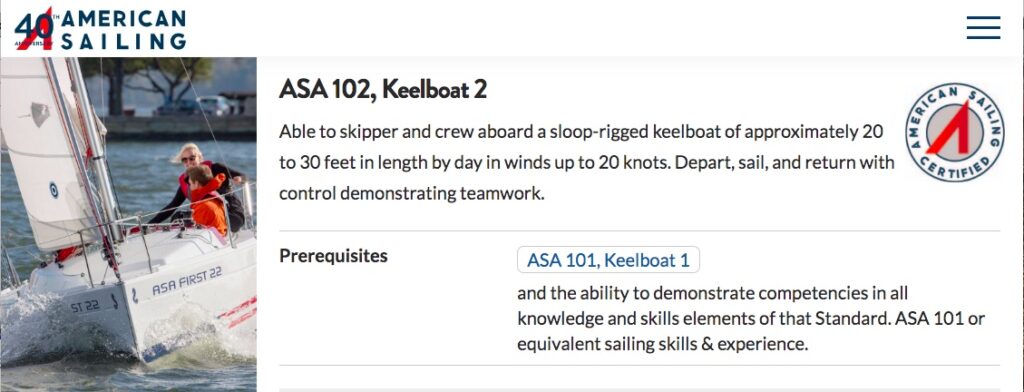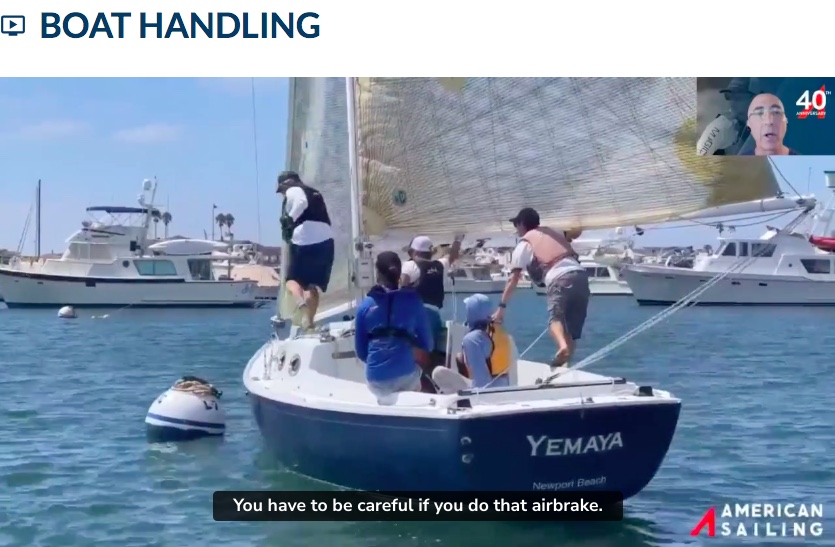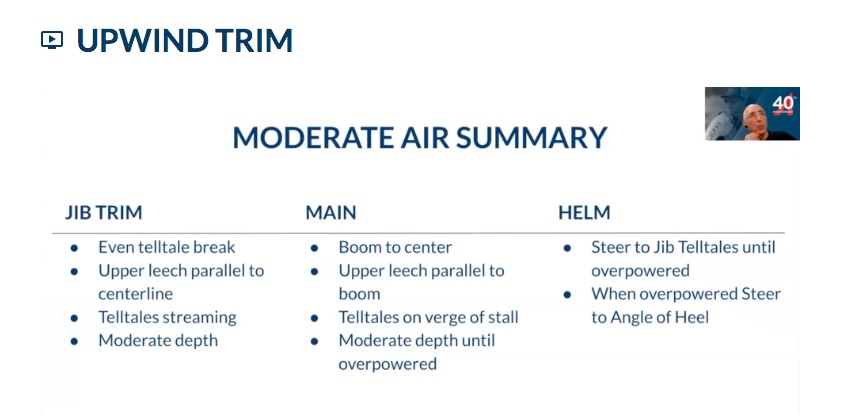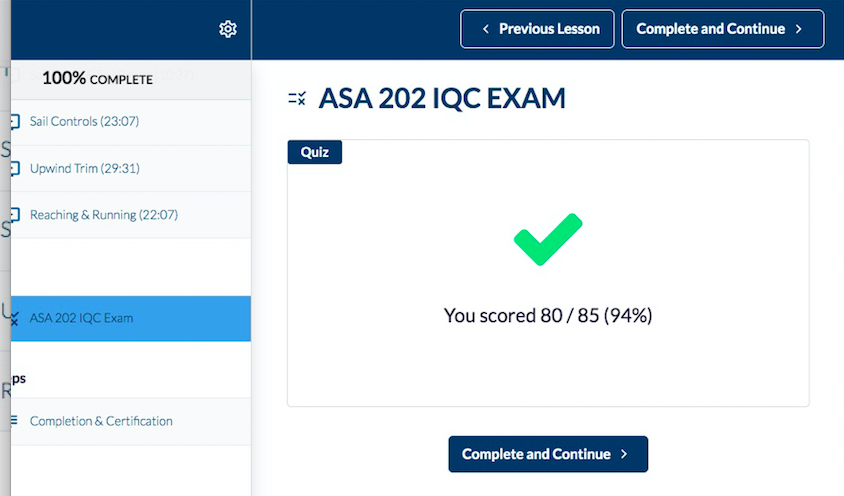We’ve actually been doing the new 102 in our learn how to sail / ASA 101 for decades. Who knew? All of our past students; soon that might be you!
UPDATE to original posting: our Director, Captain Stephen Glenn Card, is now certified at 202, meaning he’s authorized to teach and certify students for 102, and one of the earliest instructors to earn that rating.
We’re setting up ASA 102 schedules now for March and April, before our full 3-day 101/102 courses begin. Prerequisite: ASA 101 or comparable experience and skills. Can also do this as private instruction. Contact us to discuss, or read on for more about 102.
I’ve lost more time than I care to calculate with an abacus or slide rule explaining what 102 was over the decades.
There IS no 102.
Me…
There is NOT one.
Myself…
ASA missed that one.
and I.
So, it was with a combination of surprise and relief that ASA recently announced they’d filled in the gap. What is it?

It’s largely core, critical basic sailing skills that were never mandated in the 101 standards. It also has good content that, while not mission critical, is important enough that we’ve always included it in our 101. And, by always, I’m talking over 50 years of family therapy – er, experience – which began well before “101,” or even ASA, existed.
We sort of saw this coming. In 2020, I wrote a prescient post with this title: “‘102:’ When 101 Didn’t Add Up For You.” ( This rant was about how our course was complete, most others weren’t, and why we were planning to add a clinic to finish what other schools started.)
What’s in the new 102 that wasn’t already in 101? (Again, we’re talking ASA’s standards, not ours.) Major skills in 102:
- heaving to (2 methods)
- approaching moorings (2 methods)
- getting out of irons
- sailing backwards
- steering with sails and weight
- quick-stop MOB (as an addition to figure 8 already in 101)
- reefing (barely discussed in the online 102 course; not on test)

Most of the rest of the content is about sail shape, trim, lift and power, and weather helm.
Of all the things above, here’s what we don’t already cover:
- sailing backwards (we discuss but don’t do as the technique is dangerous)
- quick-stop MOB (as we disagree with it and think it’s dangerous)
That’s it! While 102 goes into more detail on sail shape than we do, we cover all the same stuff in our 101/Start Sailing course.
I think it’s a disservice to students and an insult to their intelligence to not start courses with sailing theory: how sails use wind to create power, and how that makes a boat go. Therefore, I’m a fan of keeping that in students’ minds and refining it. This is the “why” that governs all the “wha?” So, when ASA announced that sail shape was an integral part of 102, I was on board with that.

What else is in 102? Some examples…
- How to use a winch and winch handle safely (covered in 101 but I guess worth repeating)
- Basic nomenclature (redundant).
- How to tack and jibe properly in detail: timing, weight placement, who does what when, etc. (Good; refines the basics.)
- Heading up and bearing off in more detail (also good, although it’s so simple 101 should have taken care of it)
- Ducking when getting around a moored or anchored boat (excellent; we already teach duck or tack. For some reason, they never say tack. It’s often the better choice.)
- And more!
I disagree somewhere between mildly and militantly with some of the curriculum and techniques; you saw that above with their mooring approach and using the main as an airbrake. Having said that, the idea is to give students more skills, more comprehension, and more ideas about their sailing future. We can work with this.
Another example:
ASA says that heeling causes weather helm. Agree. (The wrong choice of sail plan can also do this.) But, why? They say it’s because the CE is out to leeward, or sideways, of the CLR. CE is Center of Effort (geometric middle of the combined sail plan in use). They say this causes rotation that turns the boat into the wind.

We say: nah, bruh… It’s the heeling itself that causes the weather helm. Why?
Unlike the ones depicted above, real boats have real curves. Pushing a boat’s curved, buoyant surface down into the water on the leeward side makes the boat follow that curve. Surprisingly similar to pressing down on the edge of a ski or snowboard and “decambering” it (depending on type of shape of course), and locking into a carve. The plank follows the curve. Our students who ski or ride at intermediate or higher levels get the analogy. Those who don’t get the explanation without the analogy.
ASA’s idea that the sail forces (CE) have a rotational component misses how lift works: the net sum of the sail plan (CE) has a final, single velocity: direction and power/speed. The direction is diagonally sideways to the boat, but in a straight line. It tries to pull whatever it’s attached to IN THAT STRAIGHT DIRECTION. The shape of the boat plus the keel underwater resist getting pulled sideways, for various and interesting reasons we cover in day 1 of 101. (ASA’s 102 course explains how the keel develops lift to stop that; good. This belongs in 101!) In fact, when the boat heels, the force is no longer horizontal to the water’s surface. It’s slightly to moderately downward as well. That not only increases heeling, but decreases the net drive forward as the energy is wasted. Instead, it increases the rotation of the boat caused the boat’s curved shape itself!
ASA points out that when pushing the main and boom all the way out and forward to sail backwards, it tends to turn the boat the other way (rotation) and therefore one probably has to offset the rudder slightly. That’s a rotation I can get my head around. They wisely point out that the rudder should be held firmly with two hands, although they don’t illustrate “why” well enough. We cover that concept in our cruising courses as, with engines that are BBB rated (Balls Beyond Belief), the rudder will slam hard over as the pivot point is behind the rudder rather than the udder way around when goin fowad. It’s dangerous in both cases: tillers swinging hard over, and wheels spinning freely, can bust you up quick. Plus, the entire steering system can be damaged and disabled.
And, so, I “took the lesson” as my fencing coach in college would have said, and then took the test…

So… how are we going to handle this 102 stuff? That’s in the works now. Plan A is to simply offer the 102 with the 101 for new students. As it’s not a prerequisite for anything else, and therefore “elective,” they can choose to take the exam or not. Same education either way. If they choose to, they can pay the fee for the extra ASA textbook when it’s ready (not at the time of this writing) and do the exam.
We’d also offer it as a stand-alone clinic/course for our grads who are rusty, or for highly qualified graduates of other schools’ 101 courses. That’s the logistical bear to burden us. We’ll figure something out.
But, it’s nice to know that we’ve been doing this, more or less, all along… giving you more of what you go to sailing school for!SM